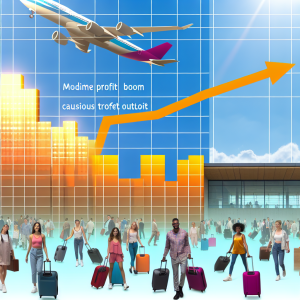As we cruise through the summer travel season, the airline industry is navigating a complex sky of challenges and opportunities that savvy investors and advisors must decode to stay ahead. The July 4 holiday period promises bustling airports and millions of travelers, yet the broader outlook for the rest of 2025 remains clouded by a persistent mismatch: too many flights chasing too little demand.
Summer Airfares: A Buyer’s Market or Warning Signal?
Southwest Airlines CEO Bob Jordan’s candid admission that “the summer is on sale” is a telling sign. Domestic round-trip fares average $265 this summer, down 3% from last year and the lowest since 2021, per fare-tracker Hopper. The May inflation report showed airfare prices down over 7% year-over-year — a significant drop that signals airlines are aggressively competing for passengers.
But beneath these bargain fares lies a cautionary tale. Airlines like Southwest, Delta, American, and Alaska have all pulled their 2025 forecasts earlier this year, citing economic uncertainty, shifting tariff policies, and a surprising dip in international visitors. This hesitancy is no small matter; it reflects a sector still grappling with the aftermath of pandemic disruptions and evolving consumer behavior.
Demand: Tepid, Not Tumultuous
While the broader economy has shown resilience—evidenced by stronger-than-expected job growth in recent U.S. labor data—the airline industry’s demand curve tells a different story. TD Cowen analyst Tom Fitzgerald aptly describes it as “tepid.” Bank of America’s debit and credit card data reveal an 11.8% decline in air travel spending in June compared to a year ago, marking the sixth consecutive month of year-over-year declines.
This spending trend suggests that while travelers are still flying, they are more price-sensitive and selective. Airlines are responding by trimming unprofitable flights, especially during off-peak periods after the summer rush, aiming to protect margins in the traditionally profitable second and third quarters.
International Travel: A Mixed Bag
International travel from the U.S. is a bright spot but not without its own dynamics. Flights abroad have increased 4.3% compared to last summer, benefiting global carriers like Delta, American, and United. Yet, fares have eased significantly—European flights averaging $817, nearly $100 less than last year, and Asian routes down 13%, according to Hopper.
This price softness internationally reflects a competitive market landscape and shifting demand patterns, possibly influenced by economic pressures abroad and changing traveler preferences.
What This Means for Investors and Advisors
-
Focus on Profitability Over Growth: Airlines are cutting capacity and focusing on profitable routes. Investors should prioritize carriers demonstrating disciplined capacity management and cost control rather than those chasing top-line growth at any cost.
-
Watch Earnings for Clues: Delta’s upcoming earnings report will set the tone. Look for management’s commentary on demand trends and capacity adjustments—positive signals could indicate a more stable recovery, while caution may suggest prolonged softness.
-
Consider Ancillary Revenue Streams: With ticket prices under pressure, airlines are increasingly reliant on ancillary revenues (e.g., baggage fees, seat upgrades). Companies innovating in this space may offer better resilience and upside potential.
-
International Exposure as a Differentiator: Airlines with strong international networks stand to benefit from global travel recovery but must navigate fare pressures. Investors should assess how carriers balance these dynamics.
A Unique Insight: The Rise of Hybrid Travel Models
One trend not widely discussed is the growing adoption of hybrid travel models combining leisure and remote work. According to a 2024 survey by McKinsey, 38% of business travelers plan to extend trips for leisure purposes. Airlines that tailor offerings to this hybrid traveler—through flexible booking, premium economy options, and enhanced in-flight connectivity—could unlock new revenue streams and customer loyalty.
What’s Next?
Airlines face a delicate balancing act in 2025: managing capacity, navigating economic uncertainties, and adapting to evolving traveler behaviors. For investors and advisors, the key is to remain vigilant, prioritize fundamentals, and seek carriers innovating beyond traditional models.
As the industry charts its course through these turbulent skies, Extreme Investor Network will continue to provide exclusive insights and actionable intelligence to help you capitalize on emerging trends and avoid turbulence in your portfolio.
Sources:
- Hopper Fare Tracker
- U.S. Bureau of Labor Statistics
- Bank of America Debit & Credit Card Spending Data
- TD Cowen Analyst Reports
- McKinsey & Company Travel Survey 2024
Source: Airlines face investors after strong— but cheaper — July 4 holiday

